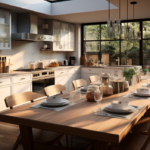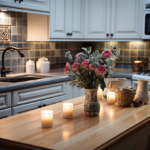Table of Contents
Practical Tips for Creating a Pet-Safe Kitchen Environment
Hey there, pet parents!
We know your fur babies mean the world to you, and when it comes to their safety, there’s no cutting corners. But have you ever given your kitchen a second glance? Odd as it may sound, our kitchens can be a minefield for our curious four-legged buddies. We’re talking about everything from tempting trash bins, easily accessible food, to the potentially harmful cleaning supplies under the sink.
But hey, don’t sweat just yet! Making your kitchen pet-friendly doesn’t mean you have to sacrifice style or functionality. Sounds like a tough nut to crack? Trust us, it’s not! With our guide on ‘Pet-Friendly Kitchen Organization’, we’ll help you transform your kitchen into a space that’s safe and enjoyable for your pets! Let us take you through the ins and outs of creating a pet-safe kitchen without giving up your favorite cooking comforts. After all, safety is the secret ingredient for a happy home, right?
So buckle up and get ready to level up your pet parenting game. Your kitchen is about to get a paw-some makeover!
Understanding Your Pet’s Kitchen Hazards
Identifying Your Pup’s Pesky Temptations
We all know Fido doesn’t mean to get into trouble, but all those scrumptious kitchen smells can lead him down a dangerous path. Understanding what attracts your pet in the first place helps establish a game plan for pet-proofing.
Common Kitchen Hazards for Pets
Remember, your pets can’t read those labels to see if something’s toxic or not! From certain foods to cleaning products, it’s essential to become familiar with common household items that may be harmful. Are your cleaning supplies stashed away in an accessible cabinet? Are the trash cans open? Pointers like these are a good starting point.
Pet-Safe Alternatives in the Kitchen
Switching to non-toxic cleaning fluids and installing child-proof locks on cabinets are simple measures that can effectively reduce risks. Do you know that safe food storage can also discourage your pet from dumpster-diving? Let’s dive into some pet-friendly changes that can make a big difference.
Tips for Organizing A Pet-Friendly Kitchen
At the end of the day, a safe kitchen for your pet boils down to organization. So, let’s look at some handy hacks, like securing trash bins and placing harmful foods out of reach, that will give you peace of mind when leaving your pet unattended.
Crafting a Pet-Proof Setup: Storage and Design Tips
Smart Storage Solutions: Out of Reach, Out of Trouble
Your four-legged pals are flexible, persistent and, let’s admit it, super sneaky when it comes to reaching those forbidden treasures. Start by moving potentially hazardous items, like cleaning products and certain edibles, to upper shelves or locked cupboards. Think safety-first with storage upgrades, like child-proof locks on low cabinets and sturdy, tight-lidded bins for waste disposal.
Pet-Friendly Design: The Tailored Touch
Who said that pet-friendly means drab? Your pet-safe kitchen can also be your dream kitchen. Consider designs and materials that are both stylish and durable. Think about adding a dedicated feeding station for your pet, away from hot stoves and tripping feet. Make your kitchen a no-go zone during busy meal prep times, using pet gates if necessary. Your buddies will learn the boundaries while you whip up a storm, worry-free.
Choosing Safe Kitchen Materials
From your flooring to countertops, selecting pet-friendly materials is key. Look for strong materials that can withstand the occasional pet antics. For instance, scratch-resistant and non-slip flooring will keep both your kitchen and furry friend in top shape. Who says you can’t have it all? Safety meets style right here in your pet-friendly kitchen.
Be Prepared: A Spot for Emergency Essentials ###
Incorporating a designated spot for your pet’s emergency essentials can be a lifesaver. Stock up on activated charcoal, hydrogen peroxide, and keep those emergency vet numbers handy. Accidents do happen and having what you need at fingertip’s reach is a solid plan. Prepare now, thank us later! After all, prepared pet parents are the best pet parents!
Selection of Pet-Safe Materials for Your Kitchen
Non-Toxic Choice: Pet-Safe Paints and Finishes ###
When choosing paints or finishes for your kitchen, it’s important to pick options that are low in VOCs (volatile organic compounds). These compounds are not just harmful for us humans, but they’re seriously toxic for our little fur buddies too. Always keep an eye out for low-VOC or zero-VOC paints and finishes, avoiding unnecessary risk.
Floor Them with Safety: Pet-Friendly Flooring Choices
The flooring in your kitchen has to cope with cooking spills, dropped dishes, and, add to that, an exciting chase between your pets. So, it should be durable, easy to clean, and pet-friendly. Luxury vinyl, ceramic or porcelain tiles hit the right mark as they are both scratch and stain-resistant. Go for a less glossy finish to keep it slip-proof.
A Worktop That Works: Pet-Safe Countertops
Counter surfers, we’re looking at you! Materials like quartz are almost indestructible, don’t harbor bacteria, and stay glittery clean with a simple wipe down. Plus, they resist pesky paw scratches. Try to avoid counters with sharp edges to prevent accidents involving your furry investigator.
Eating in Style: Pet-Safe Bowls and Feeding Area
For the final touch in the pet-friendly kitchen, check out your pet’s dining area. Plastic dishes may seem convenient, but they can harbor bacteria and cause allergies. Opt for stainless steel or ceramic dishes, which are sturdy, much more hygienic, and easy to clean. Don’t overlook the placement of the feeding station either. Keep it away from human food prep areas and high-traffic zones to make meal times calm and safe.
The Ultimate Guide to Pet-Friendly Cleaning Supplies
Spot the Toxic: Common Harmful Cleaning Agents ###
First things first, let’s uncover the bad guys. A lot of handy cleaning supplies, such as bleach, ammonia, chlorine, and certain types of detergent, can actually pose serious health risks to our fur-friends. When it comes to cleaning products, knowledge is power, so read those labels and keep the harmful chemicals out of your pet’s reach!
The Green Team: Eco-friendly and Pet-safe Alternatives
Time to swap those harmful cleaners for eco-friendly and safer alternatives. Did you know that baking soda acts as a natural deodorizer and white vinegar can tackle stubborn stains? Opt for naturally derived, biodegradable products that are free from artificial colors, dyes, or synthetic fragrances.
Disinfection without Destruction: Pet-Safe Sanitizers
The goal is to keep your kitchen germ-free without harming your pet. Luckily, it’s possible with certain plant-based sanitizers that will kill those germs while being safe for pets. Essential oils, like lemon or peppermint, have natural anti-bacterial properties too. But remember, not all ‘natural’ is safe for pets, so ensure to research individual oils for pet compatibility.
Make Cleaning Fun: DIY Pet-Friendly Cleaning Products
How about making cleaning time a fun session? That’s right! You can create simple yet effective cleaning products right at home. For instance, a mixture of vinegar, lemon juice, and water can be used for general surface cleaning, and baking soda for scrubbing. Go homemade, embrace the cleanliness, and more importantly, share a safe environment with your pets. Win-Win!
Setting Boundaries: Training Tips for Keeping Pets Safe in the Kitchen
Start Them Young: Early Training Tips
Puppies and kittens are naturally curious, and a bustling kitchen can be a playground to them. Begin by teaching basic commands like “leave it”, “sit” or “stay”. By doing so, you not only establish boundaries, but also prevent your pet from harm. Remember, consistency is key, and early training yields long-term results.
Use the Gate: Pet Barriers for Safety
Even with training, a busy cook or a hot oven can spell danger for a pet. Using a pet gate to cordon off the kitchen area during meal prep is a wise idea. It provides your little one with a visible boundary and you with peace of mind. Boundaries are not limitations, but a step towards safer homes.
Safe Distractions: Entertaining Pets Away from Kitchen
Offering a distraction can save you a lot of worry. Provide interesting toys, a new chew treat, or even a snuggle-on-its-own bed. The trick is to make things outside the kitchen more fun than what’s within. Less kitchen exploration means fewer hazards – easy math!
Reward Good Behavior: Recognize and Reinforce
Positive reinforcement goes a long way. If your pet stays calm even when there’s a batch of freshly baked cookies on the counter, reward the behavior. This self-control deserves an extra belly rub, a special treat, or a burst of praise. Let them know they’re doing great, while ensuring their safety in the kitchen.
Essential Gadget Safety Measures for Pet Owners
Master the Art of Cover-up: Cords and Appliances ###
Chewy cords and shiny appliances can turn into a hazard zone with a curious fuzzball on the ground. Make sure all cords are neatly wrapped and out of paw’s reach. Cover the outlets when not in use and unplug devices. A well-organized space = a safer space.
Tame the Range: Stove and Oven Precautions
It’s hard to resist those delicious smells wafting from the stove or oven. But, those hot surfaces can cause serious burns. Always ensure that your stove’s knobs are turned to the ‘off’ position when not in use. Also, consider stove knob covers to prevent any accidental switch-ons. When it comes to fire hazards, it’s better safe than sorry.
Fridge Rules: Secure the Snacks!
That big tall box that holds the good stuff? Yup, your pet has their eyes on it. Strong magnets can help secure the fridge door from prowling paws. It may be comical to find your pet sniffing around inside, but it’s not if they eat something they shouldn’t have. Seal the deal on fridge safety.
Size Matters: Invest in Pet-Proof Containers
Think about upgrading to pet-proof containers, especially for food stored at low levels. Heavy-duty glass containers with secure lids can deter even the most determined pets. Plus, they look classy in your kitchen, too. No access to containers equals lesser troubles. After all, safe pet practices make your companionship stronger and healthier!
Food Storage: Keeping Edibles Out of Reach
Storing Human Food: Out of Sight, Out of Mind
A whiff of freshly cooked bacon can make any pet turn into a mini mountaineer, climbing your kitchen counters. Store human food, especially the pet-unfriendly kind, high up in pantries or closed cabinets. Don’t tempt your pet with easily accessible edibles, the mantra of a clutter-free, pet-safe kitchen.
Pet Food Storage: Have a Pawsome Plan
When it comes to pet food, keep the unopened bags or cans far from puppy-dog eyes and twitching cat whiskers, preferably in top shelves or secure, locked containers. Remember, an overexcited pet can easily knock down or chew open a bag of food, causing a mess or a potential health hazard. Lock it away until feeding time!
A Lid on the Garbage: Trash Can Management
Believe it or not, the trash can is a treasure box to our pets. Use a bin with a secure, tight-fitting lid or stow it away in a latched cabinet. Also, empty the bin frequently to keep foul smells (that might attract your pet) at bay. Remember, what’s trash for us might be a treat for them!
Keep ’em Fresh and Safe: The Fridge and Freezer Strategy
Fridges and freezers are marvelous inventions for food storage, but they can turn perilous when a pet invades them. Strong magnets or latches can help keep the doors shut. Also, avoid storing pet-toxic foods such as chocolate or certain fruits on the lower shelves. Your cold storage can be a safe storage, with a little extra care!
Keeping Trash Secure: Innovative Solutions
Embrace the Lockdown: Secure Lids and Automatic Systems
The smell of leftover chicken or yesterday’s fish can drive your pets crazy. Make sure your trash cans have secure, locking lids to keep the odors in and the pets out. How about an automatic trash can that opens only when a human is around? High-tech or not, a locked can is an unspoiled plan!
Out of Reach: The Elevated Trash Can Strategy
Some pets are bit too clever for their own good, figuring out lids in no time. For them, elevating the trash can off the floor or placing it on a countertop might be a sound solution. Yes, it’s unconventional, but hey, whatever works to keep your pet safe and your kitchen clean, right?
Hidden Treasures: Concealed Trash Cans in Cabinets
Another excellent yet stylish solution could be integrating the trash can into your existing kitchen cabinets. This not only hides your trash can from pets (and visitors!), but also helps free up floor space. Incorporating design with necessity is the essence of a pet-proof kitchen.
Double Duty: Dual Compartment Trash Cans
Dual compartment trash cans are a great way to separate recyclables from regular trash, keeping them safe from curious pets. These cans have separate compartments, both with secured lids, allowing you to sort your waste without risking pet safety. ‘Dual’ is cool – and secure too! For you and your pet, a clean kitchen equals a happy heart.
Pet-Friendly Kitchen Decor: Stylish yet Safe
Fur and Décor: Pet-Friendly Rugs and Mats
Who doesn’t love a soft rug underfoot while cooking? But, those fancy kitchen mats might turn into a slip-n-slide for our fur buddies. Opt for rugs with non-slip backs, ensuring both human and pet safety. Functional decor is happy decor. Who knew?
No Scratch Dilemma: Furniture and Finishings
Let’s face it: our beloved pets, especially cats, love to use furniture as scratching posts. Consider using scratch-resistant materials for your kitchen furniture and finishings. Leather or pleather are excellent, stylish choices that your pets can’t destroy. Wave goodbye to the scratch distress!
Pet Zone: Dedicated Spaces for Feeding and Chilling
Including pet-friendly spaces in your kitchen layout not only ensures that your pet is safe, but also lets them feel included in the family activities. Create a dedicated feeding area, perhaps with a built-in dish rack. Putting in a cozy bed in one corner can create a safe haven for them. Yes, style and safety can share a room (or kitchen)!
Light up the Safety: Pet-Safe Lighting Options
Whether you fancy a chic pendant lamp or stylish under-cabinet lighting, ensure it’s installed at a safe height that your pets can’t reach. Be mindful of cords and opt for a cord-hider or a cordless option if possible. Shedding light on safety in style—that’s what we’re talking about! With smart planning, your kitchen can become a space of comfort, joy, and safety for everyone in the family.
Emergency Protocols: What to Do If Your Pet Encounters Kitchen Hazards
Fast Action: First Steps in Emergencies
We hope it never comes to it, but if your pet ingests something harmful or gets injured, quick action is crucial. Remove your pet from the hazard source, check the area, and try to ascertain what happened. Stay calm and act swiftly, the two mantras to tackle emergencies.
Called the Vet: Emergency Contacts at Hand
Always have your vet’s number and the number of a 24-hour emergency animal hospital handy. Let them know of the situation promptly and follow their instructions. Sometimes, a phone call can save a life. A saved number might be a life-saver, literally!
Knowing the Heimlich: Pet First Aid Basics
Just like humans, pets too can choke on food or toys. Knowing a pet-friendly version of the Heimlich maneuver could be a game-changer in such situations. There are pet first aid classes available and it might be worth signing up for one. Safety first is safety always, even in the kitchen!
Preparedness is Key: Pet First Aid Kit
Consider keeping a pet first aid kit in your kitchen. This can include gauze, hydrogen peroxide, a digital thermometer, and some antiseptic wipes. Encountering hazards is scary, but being prepared can make all the difference. Because with pets, it’s ‘safety fur-st’! By being proactive and prepared, you can ensure your kitchen remains a heartwarming hub of your home for everyone, including your pets.
Conclusion
So, dear pet parents, we’ve walked through the adventure that is creating a stylish yet pet-safe kitchen. It turns out, with a bit of creativity and cautiousness, you really can have your cake and eat it too!
From learning about common hazards to pet-friendly designs, non-toxic cleaning solutions to titbits on storing human and pet food, we’ve covered all the bases. And hey, let’s not underestimate the power of being prepared for emergencies, right?
It’s quite a journey, but we promise, each step you take towards a pet-friendly kitchen will be worth it. The best part? No more worrying about Fido sneaking into the trash or Whiskers hopping onto the counter. Instead, you can enjoy the peace of mind that comes from knowing your little furries are safe and sound, even in the heart of your home.
Remember, the ultimate goal is to cultivate a shared living space that caters to both your desires and your pets’ needs. With love, consistency, and a sprinkle of creativity, you can create your paw-fect kitchen haven. Happy organizing, and here’s to safer, brighter, and pet-friendlier homes!









